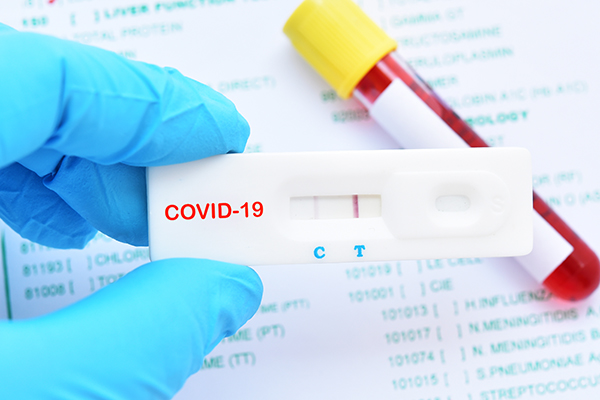
For more information, please visit the University of South Florida Coronavirus Updates site for faculty, students and staff at www.usf.edu/coronavirus.
The Centers for Disease Control and Prevention (CDC) continues to respond to the evolving global coronavirus outbreak known as coronavirus disease 2019, or COVID-19 for short. The respiratory disease, caused by a new strain of coronavirus not previously identified in humans (now named SARS-CoV-2), has been declared a “public health emergency of international concern” by the World Health Organization (WHO).
To help add some scientific context to the outbreak, we interviewed USF Health virologist Michael Teng, PhD, shortly after Florida Gov. Ron DeSantis announced the state’s first two presumptive positive cases of coronavirus (since confirmed – with positive cases continuing to rise) and issued an executive order directing a public health emergency in response.
Dr. Teng is a USF Health associate professor of internal medicine with appointments in molecular medicine, pediatrics and pharmaceutical sciences. He studies how respiratory viruses work. In particular, his research focuses on respiratory syncytial virus (RSV), a common respiratory virus that infects almost all children before age 2. He has conducted National Institutes of Health-supported research working toward a safe and effective vaccine for RSV.
SARS-CoV-2 belongs to a family of human coronaviruses, which includes four circulating strains that cause 25-30% of common colds, Dr. Teng said. Severe acute respiratory syndrome virus, or SARS, Middle East respiratory syndrome, or MERS, and now COVID-19, are caused by other human coronaviruses that can lead to more severe respiratory symptoms than the common cold coronaviruses.
The following Q&A has been condensed and edited for clarity. Some additional information (in italics) have been added to Dr. Teng’s comments:
Where did this new corona virus originate?
It was detected first in China, and Chinese health officials tracked many initial infections of the virus to a live animal market in Wuhan. Bats are the likely source of the virus but are probably not infecting people directly. Bats may have infected an intermediary animal being sold at the market and then the virus can infect humans who come into close contact with that intermediary host. This would not be the first time a coronavirus has evolved and made the leap from animals to humans – a process known as zoonosis. SARS coronavirus moved from bats to civet cats and then to humans around 2002-03, and MERS coronavirus, first identified in 2012, was transmitted from camels to humans.

USF Health virologist Michael Teng, PhD, studies how viruses work and has conducted NIH-supported research working toward a safe and effective vaccine for respiratory syncytial virus.
As testing for COVID-19 infection expands in state laboratories, do you expect to see more positive cases?
That seems very likely, because this appears to be a very transmissible respiratory virus. The symptoms are mild for most people who are infected. But some – usually the elderly, those with compromised immune systems, and those with underlying health conditions such as heart or lung diseases, diabetes, or asthma – have developed severe lower respiratory tract complications like pneumonia. We’re also in the middle of flu season and, in the absence of a rapid diagnostic test, it’s been difficult to tease out coronavirus from other flu-like illnesses with similar symptoms. (A rapid laboratory diagnostic test specifically for COVID-19 has recently become available, and new federal policies are scaling up capacity to perform tests.) We’ve had a diagnostic test to rule out flu and some other viruses, but all you know then is that it’s not flu or one of these other diseases.
What is “community spread?”
Community spread, or community transmission, means the disease cannot be traced back to a known source of infection by obtaining a detailed medical or travel history. For example, Dr. Teng said, one of our first two cases in Tampa Bay was travel-related — the Hillsborough County woman who contracted the virus had traveled to an area of Italy where coronavirus was widespread. The source of infection for the second case (a Manatee County man in his 60s hospitalized for pneumonia) was not identified. He had not traveled to China or any other countries reporting coronavirus outbreaks, or been exposed to someone known to be carrying the virus.
Common COVID-19 symptoms to look out for, according to the CDC, include fever, coughing and shortness of breath. These symptoms usually appear between two days and two weeks of exposure to the virus.
What do scientists like you still want to find out about this novel coronavirus as the outbreak unfolds?
It will be important to know for sure if the virus can be transmitted asymptomatically – by someone who shows no noticeable symptoms. It would also help to have a better understanding of how widespread COVID-19 is… to get a clearer picture of prevalence and the mortality rate.
Can the coronavirus change so that it could spread more efficiently?
RNA viruses like coronaviruses mutate, or change, quite frequently, sometimes even within the same person. Some of these mutations allow the virus to adapt to different conditions such as a new host (zoonosis) or immune responses. For instance, immune responses block most influenza infection, but some mutations are able to avoid immunity in the population and will transmit. These small changes are what give us seasonal flu. The virus keeps coming back and changing each year.
For me, scientifically, the question is not will the virus mutate, but how robust is the virus? How well can it ‘take’ the mutations without losing its ability to infect and adapt to humans? Because if the virus mutates too much it won’t be very infectious and spread as well.

The current outbreak of coronavirus disease (COVID-19) was first reported from Wuhan, China, on Dec. 31, 2019. As of March 5, 2020, confirmed cases had spread to 85 countries outside China.
How deadly is coronavirus?
If you look at all the confirmed cases cited by the World Health Organization, the mortality rate is 3.4% (as of March 5, 2020) — but that calculation reflects the thousands of people in China who have died. If you do the calculation for all cases outside of China, the mortality rate is lower, a little more than half (around 1.8% as of March 5, 2020). I think as we expand and improve coronavirus testing and surveillance (monitoring the spread of virus), we may see the overall mortality rate go down.
What is the context in comparison with death rates for other viral disease outbreaks?
It’s certainly not as scary as Ebola virus disease, which has an average mortality rate of 50%. And SARS, which did not spread very well, had mortality rate of 10%. (The 10-year death rate for seasonal flu cited by the National Institutes of Health using CDC figures is around 0.1%) The difference with SARS was that you had to experience symptoms to spread the infection… so people identified as infectious could wear specialized face masks, use self-quarantine or other preventive measures to help control transmission. This new coronavirus looks like it’s spreading asymptomatically, so even before you know you’re sick, you can infect other people. But, I think the coronavirus mortality rate will go down now that we have a specific rapid diagnostic test because we’ll gain a better idea of how many people have actually been infected.
What’s changed from the experience with SARS, which was the first epidemic of the 21st century?
When the SARS outbreak began in 2002, it took months to figure what unknown pathogen was causing a severe form of pneumonia. At that time scientists did not have the technology to identify it. It turned out to be a coronavirus (SARS-CoV), eventually identified visually by an image of the virus taken with an electron microscope. This time, within a month of the first case, Chinese scientists sequenced the full genome of the new coronavirus (SARS-CoV-2), using techniques like high throughput sequencing and bioinformatics for easier computational analysis. It’s pretty amazing how quickly the genome was sequenced and shared, and the science that has followed by other groups. Sequencing the genome is important for development of diagnostic tests, identifying potential treatment options and infectious disease surveillance.
Is there anything to be learned from SARS or other epidemics?
Unfortunately, one thing we didn’t learn is that we need to be better prepared. The lesson is that if you maintain strong public health programs and have surveillance in place early, you can catch these infectious disease outbreaks early. Then, you have a better chance of identifying the virus quickly and containing it, so that asymptomic people don’t start spreading (infection) in the community. Surveillance requires both well-prepared frontline health providers and regional public health laboratories equipped to do rapid testing, Dr. Teng said.
Is a drug or vaccine being developed for COVID-19?
Several potential treatments are in development, but it will take anywhere from several months to more than a year before we know if any of the candidates are safe and work in humans. This month, at the University of Nebraska Medical Center, the NIH started its first clinical trial testing the effectiveness of Gilead’s intravenous antiviral drug remdesivir as a treatment for COVID-19. Remdesivir had shown broad-spectrum antiviral activity in animal models, including against SARS and MERS coronaviruses. Gilead also recently announced two late-stage studies of the investigational drug in adults diagnosed with COVID-19, primarily across Asian countries.
Vaccines against respiratory viruses are quite challenging to create. Many have evolved to block our immune system because they need to establish a foothold in their hosts (us) in order to replicate and survive. So, you need to figure out how to release that block before you can make an effective vaccine.
An experimental messenger RNA (mRNA) vaccine by Moderna Therapeutics has the potential to both protect people from coronavirus infection and prevent transmission of the virus. It’s exciting, because it would be the first RNA vaccine on the market if it works and is FDA approved. Moderna’s vaccine is loaded with messenger RNA molecules carrying instructions for making certain coronavirus proteins. Once injected into the body, immune cells process the instructions so that the immune system recognizes the specific viral proteins as foreign and destroys them. This vaccine platform (approach) can be safer than traditional vaccines made from live, weakened viruses, or from inactivated viruses. And you can make mRNA vaccines (synthesized from a single strand of ribonucleic acid) quicker than having to grow viruses in another host (i.e., millions of chicken eggs or vats of cells).
Without any approved treatments yet, how can people protect themselves?
Many of the same things we do to try to prevent flu infection are going to work for coronavirus. COVID-19 is transmitted person-to-person basically the same way as flu. That means taking precautions like washing your hands regularly and thoroughly, trying not to touch your face, and avoiding close contact with people who are coughing and sneezing. If you don’t have access to soap and water, use a hand sanitizer with at least 60% alcohol content.
Is this newest coronavirus here to stay?
SARS emerged, spread worldwide, and we haven’t had any cases of SARS reported since. This virus may be one of those that comes up and then disappears once we’ve achieved herd immunity – that is, when many people who’ve been infected develop immunity to the virus. So far, however, we haven’t been able to control spread of this new coronavirus to different countries and states within the U.S. So, COVID-19 does look like it’s going to be around – it may end up being seasonal like the common cold coronaviruses or influenza.
For more information, please visit the University of South Coronavirus Updates site.

Like other coronaviruses, SARS-CoV-2 particles are spherical with proteins called spikes protruding from their surface. Coronaviruses are named for their crown-like shape under the microscope (from the Latin word corona meaning crown).

